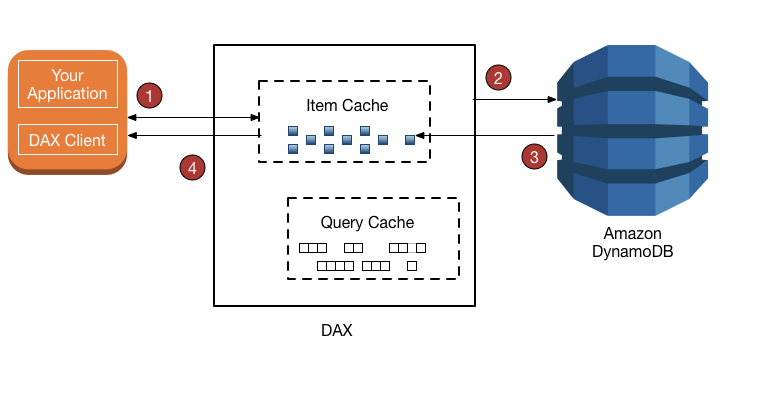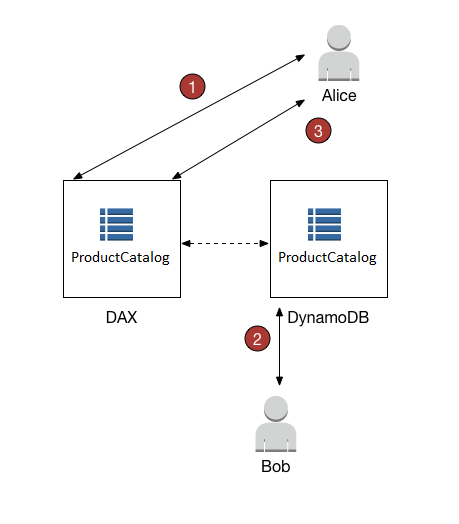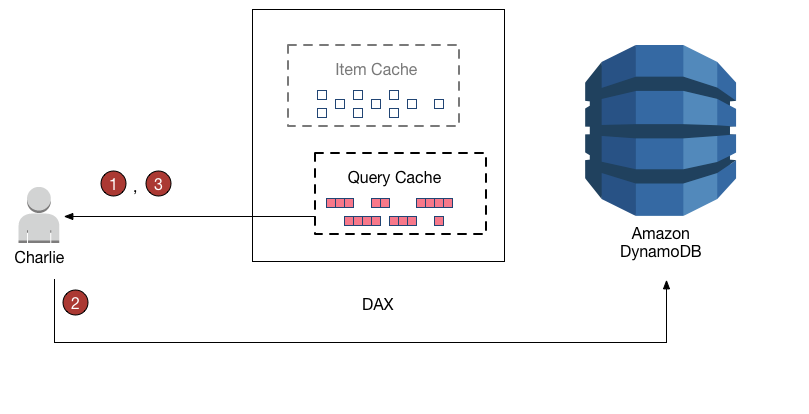DAX and DynamoDB consistency models
Amazon DynamoDB Accelerator (DAX) is a write-through caching service that is designed to simplify the process of adding a cache to DynamoDB tables. Because DAX operates separately from DynamoDB, it is important that you understand the consistency models of both DAX and DynamoDB to ensure that your applications behave as you expect.
In many use cases, the way that your application uses DAX affects the consistency of data within the DAX cluster, and the consistency of data between DAX and DynamoDB.
Topics
Consistency among DAX cluster nodes
To achieve high availability for your application, we recommend that you provision your DAX cluster with at least three nodes. Then place those nodes in multiple Availability Zones within a Region.
When your DAX cluster is running, it replicates the data among all of the nodes in
the cluster (assuming that you provisioned more than one node). Consider an application
that performs a successful UpdateItem using DAX. This action causes the
item cache in the primary node to be modified with the new value. That value is then
replicated to all the other nodes in the cluster. This replication is eventually
consistent and usually takes less than one second to complete.
In this scenario, it's possible for two clients to read the same key from the same DAX cluster but receive different values, depending on the node that each client accessed. The nodes are all consistent when the update has been fully replicated throughout all the nodes in the cluster. (This behavior is similar to the eventually consistent nature of DynamoDB.)
If you are building an application that uses DAX, that application should be designed so that it can tolerate eventually consistent data.
DAX item cache behavior
Every DAX cluster has two distinct caches—an item cache and a query cache. For more information, see DAX: How it works.
This section addresses the consistency implications of reading from and writing to the DAX item cache.
Consistency of reads
With DynamoDB, the GetItem operation performs an eventually consistent
read by default. Suppose that you use UpdateItem with the DynamoDB client.
If you then try to read the same item immediately afterward, you might see the data
as it appeared before the update. This is due to propagation delay across all the
DynamoDB storage locations. Consistency is usually reached within seconds. So if you
retry the read, you will likely see the updated item.
When you use GetItem with the DAX client, the operation (in this
case, an eventually consistent read) proceeds as shown following.

-
The DAX client issues a
GetItemrequest. DAX tries to read the requested item from the item cache. If the item is in the cache (cache hit), DAX returns it to the application. -
If the item is not available (cache miss), DAX performs an eventually consistent
GetItemoperation against DynamoDB. -
DynamoDB returns the requested item, and DAX stores it in the item cache.
-
DAX returns the item to the application.
-
(Not shown) If the DAX cluster contains more than one node, the item is replicated to all the other nodes in the cluster.
The item remains in the DAX item cache, subject to the Time to Live (TTL) setting and the least recently used (LRU) algorithm for the cache. For more information, see DAX: How it works.
However, during this period, DAX doesn't re-read the item from DynamoDB. If someone
else updates the item using a DynamoDB client, bypassing DAX entirely, a
GetItem request using the DAX client yields different results
from the same GetItem request using the DynamoDB client. In this scenario,
DAX and DynamoDB hold inconsistent values for the same key until the TTL for the
DAX item expires.
If an application modifies data in an underlying DynamoDB table, bypassing DAX, the application needs to anticipate and tolerate data inconsistencies that might arise.
Note
In addition to GetItem, the DAX client also supports
BatchGetItem requests. BatchGetItem is essentially
a wrapper around one or more GetItem requests, so DAX treats each
of these as an individual GetItem operation.
Consistency of writes
DAX is a write-through cache, which simplifies the process of keeping the DAX item cache consistent with the underlying DynamoDB tables.
The DAX client supports the same write API operations as DynamoDB
(PutItem, UpdateItem, DeleteItem,
BatchWriteItem, and TransactWriteItems). When you use
these operations with the DAX client, the items are modified in both DAX and
DynamoDB. DAX updates the items in its item cache, regardless of the TTL value for
these items.
For example, suppose that you issue a GetItem request from the DAX
client to read an item from the ProductCatalog table. (The partition
key is Id, and there is no sort key.) You retrieve the item whose
Id is 101. The QuantityOnHand value for
that item is 42. DAX stores the item in its item cache with a
specific TTL. For this example, assume that the TTL is 10 minutes. Then, 3 minutes
later, another application uses the DAX client to update the same item so that its
QuantityOnHand value is now 41. Assuming that the item
is not updated again, any subsequent reads of the same item during the next 10
minutes return the cached value for QuantityOnHand
(41).
How DAX processes writes
DAX is intended for applications that require high-performance reads. As a write-through cache, DAX passes your writes through to DynamoDB synchronously, then automatically and asynchronously replicates resulting updates to your item cache across all nodes in the cluster. You don't need to manage cache invalidation logic because DAX handles it for you.
DAX supports the following write operations: PutItem,
UpdateItem, DeleteItem,
BatchWriteItem, and TransactWriteItems.
When you send a PutItem, UpdateItem,
DeleteItem, or BatchWriteItem request to DAX,
the following occurs:
-
DAX sends the request to DynamoDB.
-
DynamoDB replies to DAX, confirming that the write succeeded.
-
DAX writes the item to its item cache.
-
DAX returns success to the requester.
When you send a TransactWriteItems request to DAX, the
following occurs:
-
DAX sends the request to DynamoDB.
-
DynamoDB replies to DAX, confirming that the transaction completed.
-
DAX returns success to the requester.
-
In the background, DAX makes a
TransactGetItemsrequest for each item in theTransactWriteItemsrequest to store the item in the item cache.TransactGetItemsis used to ensure serializable isolation.
If a write to DynamoDB fails for any reason, including throttling, the item is not cached in DAX. The exception for the failure is returned to the requester. This ensures that data is not written to the DAX cache unless it is first written successfully to DynamoDB.
Note
Every write to DAX alters the state of the item cache. However, writes to the item cache don't affect the query cache. (The DAX item cache and query cache serve different purposes, and operate independently from one another.)
DAX query cache behavior
DAX caches the results from Query and Scan requests in its
query cache. However, these results don't affect the item cache at all. When your
application issues a Query or Scan request with DAX, the
result set is saved in the query cache—not in the item cache. You can't "warm up"
the item cache by performing a Scan operation because the item cache and
query cache are separate entities.
Consistency of query-update-query
Updates to the item cache, or to the underlying DynamoDB table, do not invalidate or modify the results stored in the query cache.
To illustrate, consider the following scenario. An application is working with the
DocumentRevisions table, which has DocId as its
partition key and RevisionNumber as its sort key.
-
A client issues a
QueryforDocId101, for all items withRevisionNumbergreater than or equal to5. DAX stores the result set in the query cache and returns the result set to the user. -
The client issues a
PutItemrequest forDocId101with aRevisionNumbervalue of20. -
The client issues the same
Queryas described in step 1 (DocId101andRevisionNumber>=5).
In this scenario, the cached result set for the Query issued in step
3 is identical to the result set that was cached in step 1. The reason is that DAX
does not invalidate Query or Scan result sets based on
updates to individual items. The PutItem operation from step 2 is only
reflected in the DAX query cache when the TTL for the Query
expires.
Your application should consider the TTL value for the query cache and how long your application can tolerate inconsistent results between the query cache and the item cache.
Strongly consistent and transactional reads
To perform a strongly consistent GetItem, BatchGetItem,
Query, or Scan request, you set
the ConsistentRead parameter to true. DAX passes strongly consistent
read requests to DynamoDB. When it receives a response from DynamoDB, DAX returns the
results to the client, but it does not cache the results. DAX can't serve strongly
consistent reads by itself because it's not tightly coupled to DynamoDB. For this reason,
any subsequent reads from DAX would have to be eventually consistent reads. And any
subsequent strongly consistent reads would have to be passed through to DynamoDB.
DAX handles TransactGetItems requests the same way it handles strongly
consistent reads. DAX passes all TransactGetItems requests to DynamoDB. When
it receives a response from DynamoDB, DAX returns the results to the client, but it
doesn't cache the results.
Negative caching
DAX supports negative cache entries in both the item cache and the query cache. A negative cache entry occurs when DAX can't find requested items in an underlying DynamoDB table. Instead of generating an error, DAX caches an empty result and returns that result to the user.
For example, suppose that an application sends a GetItem request to a
DAX cluster, and that there is no matching item in the DAX item cache. This causes
DAX to read the corresponding item from the underlying DynamoDB table. If the item
doesn't exist in DynamoDB, DAX stores an empty item in its item cache and returns the
empty item to the application. Now suppose that the application sends another
GetItem request for the same item. DAX finds the empty item in the
item cache and returns it to the application immediately. It does not consult DynamoDB at
all.
A negative cache entry remains in the DAX item cache until its item TTL has expired,
its LRU is invoked, or the item is modified using PutItem,
UpdateItem, or DeleteItem.
The DAX query cache handles negative cache results in a similar way. If an
application performs a Query or Scan, and the DAX query
cache doesn't contain a cached result, DAX sends the request to DynamoDB. If there are no
matching items in the result set, DAX stores an empty result set in the query cache
and returns the empty result set to the application. Subsequent Query or
Scan requests yield the same (empty) result set, until the TTL for that
result set has expired.
Strategies for writes
The write-through behavior of DAX is appropriate for many application patterns. However, there are some application patterns where a write-through model might not be appropriate.
For applications that are sensitive to latency, writing through DAX incurs an extra network hop. So a write to DAX is a little slower than a write directly to DynamoDB. If your application is sensitive to write latency, you can reduce the latency by writing directly to DynamoDB instead. For more information, see Write-around.
For write-intensive applications (such as those that perform bulk data loading), you might not want to write all of the data through DAX because only a small percentage of that data is ever read by the application. When you write large amounts of data through DAX, it must invoke its LRU algorithm to make room in the cache for the new items to be read. This diminishes the effectiveness of DAX as a read cache.
When you write an item to DAX, the item cache state is altered to accommodate the new item. (For example, DAX might need to evict older data from the item cache to make room for the new item.) The new item remains in the item cache, subject to the cache's LRU algorithm and the TTL setting for the cache. As long as the item persists in the item cache, DAX doesn't re-read the item from DynamoDB.
Write-through
The DAX item cache implements a write-through policy. For more information, see How DAX processes writes.
When you write an item, DAX ensures that the cached item is synchronized with the item as it exists in DynamoDB. This is helpful for applications that need to re-read an item immediately after writing it. However, if other applications write directly to a DynamoDB table, the item in the DAX item cache is no longer in sync with DynamoDB.
To illustrate, consider two users (Alice and Bob), who are working with the
ProductCatalog table. Alice accesses the table using DAX, but Bob
bypasses DAX and accesses the table directly in DynamoDB.

-
Alice updates an item in the
ProductCatalogtable. DAX forwards the request to DynamoDB, and the update succeeds. DAX then writes the item to its item cache and returns a successful response to Alice. From that point on, until the item is ultimately evicted from the cache, any user who reads the item from DAX sees the item with Alice's update. -
A short time later, Bob updates the same
ProductCatalogitem that Alice wrote. However, Bob updates the item directly in DynamoDB. DAX does not automatically refresh its item cache in response to updates via DynamoDB. Therefore, DAX users don't see Bob's update. -
Alice reads the item from DAX again. The item is in the item cache, so DAX returns it to Alice without accessing the DynamoDB table.
In this scenario, Alice and Bob see different representations of the same
ProductCatalog item. This is the case until DAX evicts the item
from the item cache, or until another user updates the same item again using
DAX.
Write-around
If your application needs to write large quantities of data (such as a bulk data load), it might make sense to bypass DAX and write the data directly to DynamoDB. Such a write-around strategy reduces write latency. However, the item cache doesn't remain in sync with the data in DynamoDB.
If you decide to use a write-around strategy, remember that DAX populates its item cache whenever applications use the DAX client to read data. This can be advantageous in some cases because it ensures that only the most frequently read data is cached (as opposed to the most frequently written data).
For example, consider a user (Charlie) who wants to work with a different table,
the GameScores table, using DAX. The partition key for
GameScores is UserId, so all of Charlie's scores would
have the same UserId.

-
Charlie wants to retrieve all of his scores, so he sends a
Queryto DAX. Assuming that this query has not been issued before, DAX forwards the query to DynamoDB for processing. It stores the results in the DAX query cache, and then returns the results to Charlie. The result set remains available in the query cache until it is evicted. -
Now suppose that Charlie plays the Meteor Blasters game and achieves a high score. Charlie sends an
UpdateItemrequest to DynamoDB, modifying an item in theGameScorestable. -
Finally, Charlie decides to rerun his earlier
Queryto retrieve all of his data fromGameScores. Charlie does not see his high score for Meteor Blasters in the results. This is because the query results come from the query cache, not the item cache. The two caches are independent from one another, so a change in one cache does not affect the other cache.
DAX does not refresh result sets in the query cache with the most current data
from DynamoDB. Each result set in the query cache is current as of the time that the
Query or Scan operation was performed. Thus, Charlie's
Query results don't reflect his PutItem operation.
This is the case until DAX evicts the result set from the query cache.